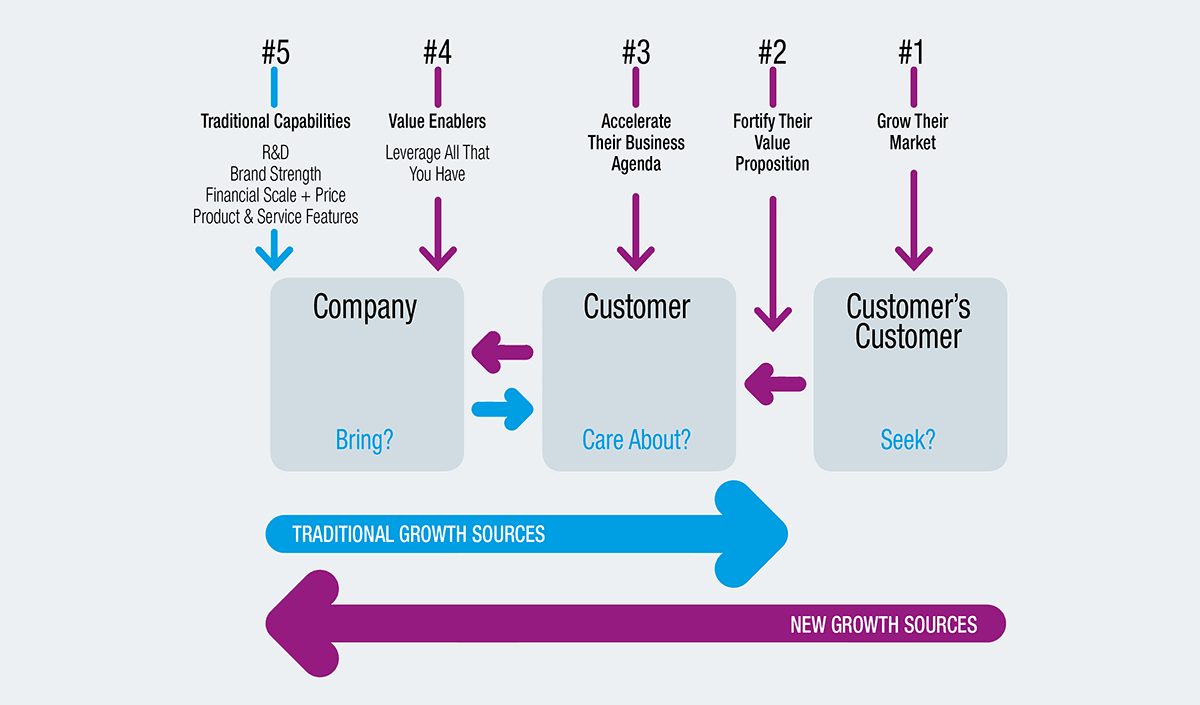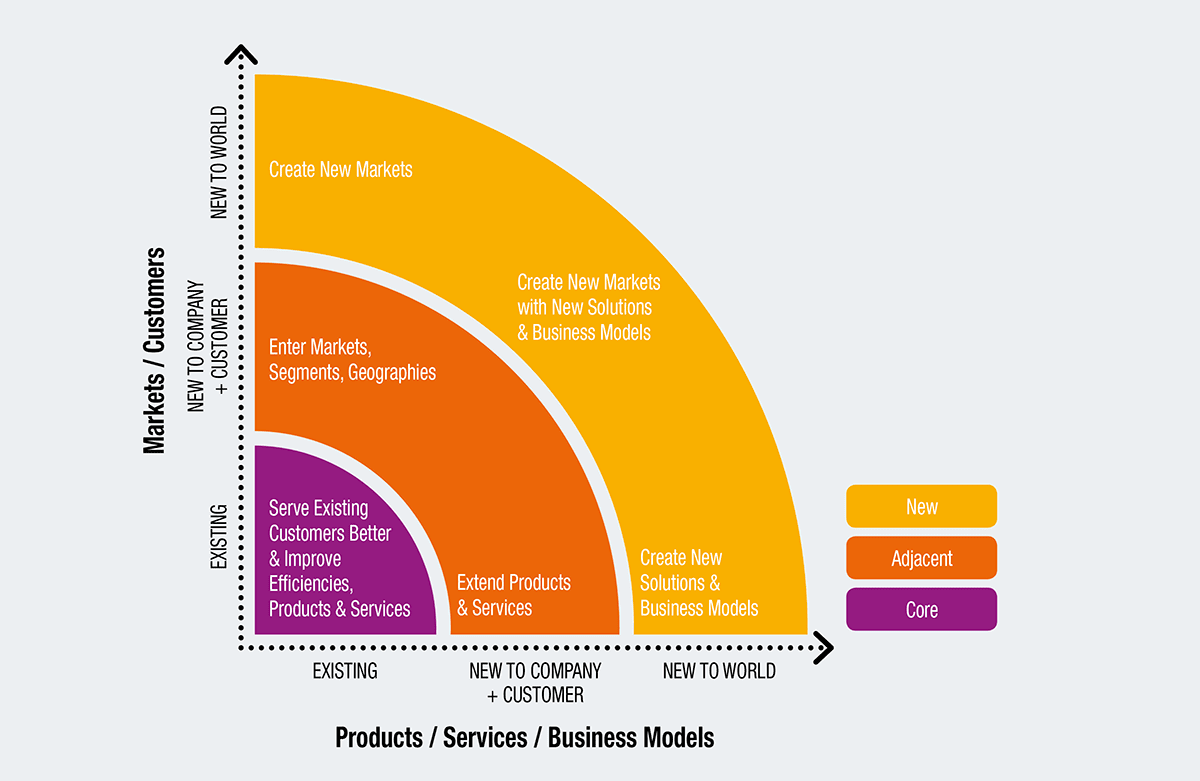Growing together
25th June 2019 | Phil Styrlund and James Robertson
How to work with strategic customers to create joint solutions for growth.
Article summary
Persistent, disruptive forces impacting profitable growth are intensifying, and as a result, companies in many industries face slower growth and accelerating commoditization of product and service margins.
Given marketplace complexity and dynamic shifts in how customers buy, traditional business models are threatened and new strategies and capabilities for driving growth must be more intentionally developed.
Here, we outline a pragmatic, yet powerful framework for co-creating solutions with strategic customers, drawing on research, emerging practice, and learning from what leading companies are doing differently to collaboratively create value and accelerate growth with customers in their hyper-competitive business environment.
Traditional sources of growth, such as internal research and development of products and services, pricing, and branding – the capabilities within the firm’s direct control – remain important, but are no longer sufficient to sustain growth.

Figure 1: Sources of growth – both traditional/internal and new/external.
Increasingly, leading firms are engaging with customers and partners along their value chain to co-create new sources of value, by deepening insights, aligning goals, developing joint solutions, harnessing mutual capabilities, and executing together (Figure 1).
Successful joint solution creation requires an iterative, non-prescriptive, collaborative operating system – integrating a framework, principles and tools, and distinguishing competencies that enable business alignment, customer-driven insights, collaborative relationship development, and co-creation.
Companies should not underestimate the barriers to successfully developing joint solutions with customers. The legacy products, competencies, organization structure, mindset, and culture that enabled success in the past are likely to get in the way of collaboratively creating joint solutions, and re-thinking how value is created with customers.
Creating joint solutions is a team sport, not something we try alone. For many organizations, the level of collaboration and trust required with strategic customers – and also internally across the enterprise – is highly challenging. Yet the rewards for developing this capability, and effectively creating joint solutions, can be substantial, with leading companies reporting growth at up to three times the market rate, and double the progression of their business with other customers. 1
Why create joint solutions?
The easy growth is over. As marketplace change accelerates, complexity increases, commoditization intensifies, and technology disrupts previously successful business models, companies seek new strategies to invigorate and sustain profitable growth – to survive and thrive in this “new normal” environment.
Considering the seismic shifts that continue to impact how companies go to market and grow, creating joint solutions with customers has emerged as, arguably, the most compelling, powerful strategy for companies to accelerate and sustain profitable growth.
Beyond accelerating and sustaining growth, creating joint solutions enables companies to:
- Use the customer to guide, shape and accelerate company change and transformation. Possibly the “grandest why” is to use the customer as the central source of navigation for your company’s strategy and culture shift from “inside-out” to customer-driven.
- Distinguish how they engage with customers, creating value through the co-creation process, not only by what they sell. Done right, co-creation is a differentiating competitive strategy, that’s hard to imitate.
- Elevate and sustain relevance by dialing up their agility to align with, and collaboratively create, solutions that impact their customers’ most critical clinical/technical, business and financial priorities, unmet needs, and “CareaboutsTM”. Importantly, customer expectations are shifting fast – and there is little tolerance for “telling me what I already know” or not being highly relevant.
- Strengthen, expand, and deepen strategic relationships, moving well beyond “preferred supplier” status, to be seen as trusted co-innovators and business advisers.
- Create and sustain mutual value beyond the product by developing new revenue streams, developing new business models, reducing costs, and improving efficiencies. Paradoxically, leading companies find that as they create value beyond the core product, sales of core products and services increase.2 Also, by quantifying and communicating value beyond the product, companies counter commoditization and price pressure. While price remains important, it need not be the only factor.
- Innovate more effectively by bringing new-to-company ideas, capabilities, and insights that result in new products, services, and solutions. As one of our clients said, “Neither company would have achieved these results on our own.”
- Mitigate risks inherent in traditional innovation by reducing market access and demand uncertainty.
- Accelerate entry into new markets.
- Expand value and impact by replicating, cascading, and scaling to other customers and new accounts.
Ultimately, creating joint solutions is about increasing customer value and accelerating and sustaining profitable growth – fueling the lifeblood of business. However, as compelling as the logic may be, creating joint solutions can be one of the toughest strategies to execute.

Figure 2: Opportunities for creating joint solutions.
What do we mean “creating joint solutions”?
Creating joint solutions is the collaborative development and deployment of new products, services, solutions, processes, and/or business models that impact mutually prioritized opportunities to create value, differentiation, and profitable growth for both the company, their customers – and the customer’s customer.
Opportunities for creating joint solutions span from incremental improvement of existing products and services, to creating new-to-the-world solutions, developing new business models, and entering new markets. Value may be co-created at three levels of product/service, business model, and market opportunity (Figure 2):
- Core – with existing products and services, in existing markets.
- Adjacent – entering and extending with new-to-company and/or new-to-customer products and markets.
- New – new-to-the-world products and services, business models, markets and customers.
Creating joint solutions is not traditional large account selling. It’s something we do with, not to the customer. The hallmark operating principles for effectively creating joint solutions are:
- Outside-in thinking
- Focus on the customer’s customer
- High levels of collaboration, transparency, and trust
- Business alignment and mutual prioritization of opportunities
- Value creation and business impact for both the company and the customer
- Joint resourcing and decision-making
- Senior-level leader support and sponsorship
- Balancing creative, strategic thinking with disciplined execution
- Leveraging relevant strengths and capabilities of both organizations
- An agile, iterative process – enabled by continued feedback and learning.
In the next edition we will introduce a pragmatic, real-world framework for co-creating with customers, explore a business-case example, and share lessons learned – what works and traps to avoid – based on the experiences of leading companies across industries.
References
1 TSG SAM/Co-Innovation Benchmark Assessments, 2010 – 2015.
2 Technology companies refer to this as the “attach rate” – the incremental core product sales generated as a result of bringing new solutions and services to market.




